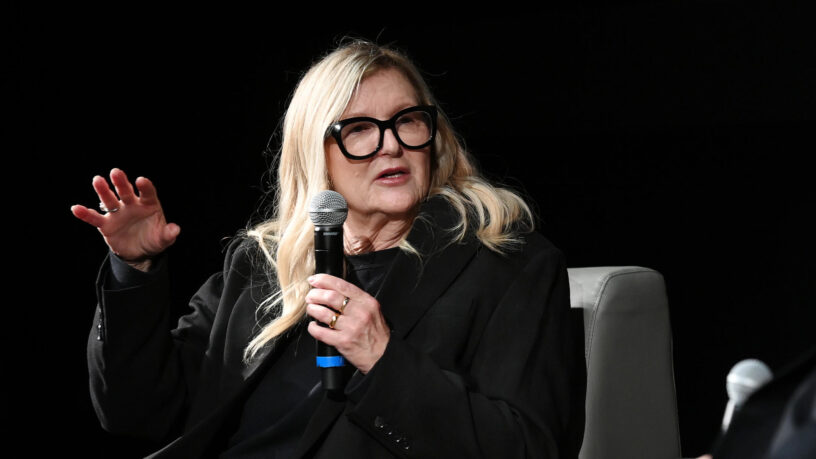While much of the movie’s epic story-line will unfold on Arrakis, Dune: Part Two will also transport audiences to the unique home planets of House Corrino and House Harkonnen. Costume designer Jacqueline West, attending the Qatari Doha Film Institute’s annual event as a master of her craft, spoke briefly about what we can expect to see in Villeneuve’s second Dune movie and shared some insight into her creative process.
Visiting Kaitain and Returning to Giedi Prime
During the masterclass, West—who has earned Oscar nominations for Dune: Part One, as well as her past work on The Revenant, The Curious Case of Benjamin Button, and Quills—confirmed that audiences will experience the Imperial capital on the big screen.
In [Dune: Part Two], you really dive into the different worlds of Dune. We see what the emperor’s world looks like. We go to his planet.
Jacqueline West
Above clearly refers to Kaitain—though she doesn’t mention the planet by its name—where the Padishah Emperor Shaddam IV, played by Christopher Walken, is seated on the Corrino’s Golden Lion Throne. This world leaves first-time visitors in awe, both for its beauty and prosperity. Everything we’re hearing now corroborates with last summer’s Dune: Part Two shoots in Italy, featuring Florence Pugh as Princess Irulan, being for scenes set on Kaitain.
While Dune: Part One included several scenes on Giedi Prime, it’s exciting to hear that the second movie will return to the Harkonnen homeworld and spend significant amounts of time there. This is where the film will introduce Austin Butler’s character Feyd-Rautha Harkonnen—showcasing his knife-fighting prowess in the arena—as it seeks to establish the Baron’s heir as a dangerous rival to Paul Atreides.
We spend a lot of time on Giedi Prime, the Harkonnen planet. We spend a lot of time in Stellan Skarsgård’s [the Baron] world. Feyd-Rautha also comes into this one, brilliantly played by Austin Butler (Elvis). He is pretty fabulous in it.

While there’s no indication that any scenes will take place on Wallach IX (the Bene Gesserit homeworld), the second movie will further explore the Sisterhood.
All the worlds get expanded. It was about creating three separate, different-looking worlds and also revisiting the Bene Gesserit, the age-old ones with these costumes that almost look like Egyptian mummies. I think it’s visually stunning, the sets, the cinematography and the concepts.
Creating the Costumes of Dune
With the movie unveiling more of both Arrakis and Giedi Prime, it’s not surprising to hear West say that Dune: Part Two was a lot more labor intensive than the first movie, “We made a lot of costumes.”
The designer elaborated on her influences to designing the film’s diverse range of attire. When it come to the interior costumes on Arrakis, West looked to inspiration from the nomadic Touareg people, as well as historical Middle Eastern paintings.
I spent time in Morocco, I was always fascinated by the “Blue Men in the desert”, the Touaregs who would wrap their faces in the cloth and how the dye would come off on their faces. It was a beautiful image for me, and I always remembered the robes and the wraps.
West maintained a high level of attention to detail throughout the process, whether it was the meticulous research or having the cotton cloth robes—as worn by the movie’s leads—specially handmade by her friend in Italy.

One of the iconic and unique elements of Dune is its stillsuits. West teamed up with concept artist Kieth Christensen to realize a convincing design, that felt like it really protected users from the harsh conditions of the desert.
It had to have all of the pumps and the tubing had to be somehow visible so you could believe it could [recycle the wearer’s moisture].
It wasn’t just the appearance that had to be perfected. West had to ensure these stillsuits would be comfortable, knowing that actors would be wearing them for extended periods in the heat of the desert. She explained how the costumes were actively cooled:
[We added] little holes to make them breathable, and we had little fans embedded in those holes, powered by LEDs, so it would help evaporate the sweat.
The Dune Encyclopaedia (1984), by Willis E. McNelly, was also used as reference material. “Some people don’t trust that encyclopaedia, but it’s pretty well documented,” West said.
Zendaya’s “Nomad” Dress
Interestingly, some of Zendaya’s solo desert scenes were in fact filmed in California, rather than Jordan or the United Arab Emirates. In those striking vision sequences, Chani is wearing an ankle-length white dress.
We were shooting out in the Californian desert, east of Bakersfield, a pick-up shot with Zendaya. It’s the first time you don’t see her in a stillsuit. They haven’t made it to the sietch yet, so you don’t see the sietch clothing until Dune: Part Two.

West revealed that this costume has more earthly origins. Back in the 1990s she had designed a clothing line for Barneys, titled the Nomad Collection. When asked out-of-the-blue about a dress for Zendaya, she reused one of those outfits.
Denis asked if I had a dress for her and I was like: “A dress? No, she never wears a dress in the script.”
I went home that night and went through my sample trunk from my old clothing line and found that dress. She just walked into it and fell in love with it and so in Dune: Part Two, [Villeneuve] said, “can we do more of your Nomad Collection?”
Turning Down Denis Villeneuve
Different from stories we’ve heard of so many cast and crew members who jumped at the opportunity to work on Dune: Part One, West actually turned down Villeneuve initially. The director had contacted the costume designer’s agent, following her work on The Revenant. It was the film’s genre that caused West’s hesitation.
I said, “I don’t do sci-fi. It’s not my thing.” I said no. [Denis Villeneuve] hired someone else, and I guess he wasn’t happy because he called my agent a second time and said, “Can I just talk to her?” Mary Parent, who produced The Revenant and was producing Dune, got me in her office and put me on FaceTime with him on a big screen.
He was so compelling. He said, “I want you because I do not want it to look like sci-fi. I want it to be classical. I don’t want it to look like a video game.”
Hidden Items in the Costumes
In an interview with Screen (during the same event), West talked about how she’s kept a long-going tradition of placing special items in actors’ costumes. These remain secret, not making an appearance in the respective films.
During production of Dune: Part One she gifted Timothée Chalamet a unique scarf “inside his suit”, made from “very fine prima cotton.” This featured an image of Muad-Dib, the little desert mouse of Arrakis. The scarf came in handy for the actor, since “the suit was rubbing on his neck.”
And for Dune: Part Two, Zendaya—returning for a much larger role—was given a “special amulet.” West didn’t offer any further details on that item.
2023 is a big year for the costume designer. In addition to Dune: Part Two, her work will be featured in Martin Scorsese’s Killers of the Flower Moon. Regarding the latter, which is set to premiere at Cannes Film Festival the May, West said, “I had the most incredible experience of my film career.”
Denis Villeneuve’s Dune: Part Two movie is currently in post-production and scheduled for release in November 3, 2023.



